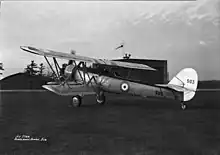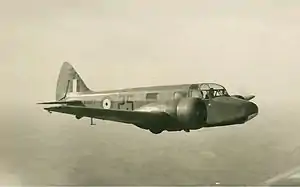| 758 Naval Air Squadron | |
|---|---|
| Active | 1 July 1939 - February 1941 25 May 1942 - 14 May 1946[1] |
| Country | |
| Branch | |
| Type | Fleet Air Arm Second Line Squadron |
| Role |
|
| Size | Squadron |
| Part of | Fleet Air Arm |
| Insignia | |
| Identification Markings | X5A+ (1939 - 1941) U1A+, U3A+, U1AA, U1BB+, U3AA+ & U3BB+[2] |
.jpg.webp)
758 Naval Air Squadron (758 NAS) was a Naval Air Squadron of the Royal Navy's Fleet Air Arm. It was initially formed as a Telegraphist Air Gunner Training Squadron, from 1939 and 1941, renumbered from 759 Naval Air Squadron, operating out of RNAS Eastleigh (HMS Raven). It moved to RNAS Arbroath (HMS Condor), in 1940, disbanding there the following year. The squadron reformed at RNAS Donibristle (HMS Merlin), in 1942, as a Beam Approach School. Moving to RNAS Hinstock (HMS Godwit), it was known as the Naval Advanced Instrument Flying School. It provided instrument courses, utilising a large number of Oxford aircraft, with detachments sent to the specialised flying schools at RNAS Crail (HMS Jackdaw), RNAS East Haven (HMS Peewit), RNAS Fearn (HMS Owl) and RNAS Yeovilton (HMS Heron). 'X' and 'Y' Rover Flights supplemented the detachments, 'Z' Flight was on calibration work and evolving homing and landing capabilities, with the squadron disbanding in 1946, at RNAS Peplow (HMS Godwit II), into 780 Naval Air Squadron.[2]
History of 758 NAS
Telegraphist Air Gunner Training Squadron (1939 - 1941)

758 Naval Air Squadron formed at RNAS Eastleigh (HMS Raven), in Hampshire, on 1 July 1939, as a Telegraphist Air Gunner Training Squadron, re-numbered from 759 Naval Air Squadron and as part of No.2 Air Gunners School. It operated with Shark II, Osprey III and Proctor Ia and IIa aircraft.[3]
The squadron continued Telegraphist Air Gunner training from Eastleigh, throughout the following fifteen months, before moving to RNAS Arbroath (HMS Condor), East Angus, Scotland, on the 14 October 1940. Here, the squadron was equipped with Proctor, Roc and Skua aircraft, continuing TAG training for a further four months, eventually disbanding on the 1 February 1941.[4]
Naval Advanced Instrument Flying Training Unit (1942 - 1946)

758 Naval Air Squadron reformed at RNAS Donibristle (HMS Merlin), near Dunfermline, in Fife, on 25 May 1942.[5] Operating Oxford aircraft, the squadron remained at Donibristle for around three months, moving to RNAS Hinstock (HMS Godwit), in Shropshire, on the 15 August 1942.[6]
It was initially known as the Beam Approach School, then later known as the Blind Approach School. In 1943 it was titled Naval Advanced Instrument Flying School and as well as Oxford aircraft, the squadron also operated Anson, Reliant, Tiger Moth, and Wellington aircraft. Later in the year Harvard aircraft replaced the Wellingtons and by 1944, 758 NAS had over 100 aircraft.[7]
Detachments went to RNAS Crail, RNAS East Haven, RNAS Fearn and RNAS Yeovilton, the Specialised Flying Schools, to supply instrument training courses. The detachments work was reinforced by X and Y Rover Flights, while Z Flight, a calibration flight, also worked on enhancing homing and landing assistance.[2]
The relief landing grounds, at RNAS Weston Park (HMS Godwit II),[7] situated in the grounds of Weston Park, a country house in Weston-under-Lizard, Staffordshire, and RNAS Bratton,[8] located at Bratton, Shropshire, were used by 758 NAS for Instrument Flying Training, until Hinstock gained Peplow as a satellite airfield, from 28 February 1945 and the squadron then operated from RNAS Peplow (HMS Godwit II), situated just outside Peplow in Shropshire.
On the 18 March 1946 the squadron absorbed part of 798 Naval Air Squadron,[7] however, 758 NAS disbanded on the 14 May 1946, at Peplow, becoming 'B' Flight of 780 Naval Air Squadron.[9]
Aircraft flown
The squadron has flown a number of different aircraft types, including:[3][10]
- Hawker Osprey III (Jul 1939 - Jun 1940)
- Blackburn Shark Mk II (Jul 1939 - Sep 1940)
- Blackburn Skua Mk.II (Oct 1939 0 Feb 1941)
- Blackburn Roc Mk.I (Nov 1939 - 1940)
- Percival P.28 Proctor IA (Dec 1939 - Feb 1941)
- Percival P.30 Proctor IIA (Aug 1940)
- Airspeed Oxford (May 1942 - May 1946)
- de Havilland DH.82 Tiger Moth (Feb 1943 - Sep 1945)
- Vickers Wellington GR Mark XI (Sep 1943 - Dec 1943)
- Stinson Reliant I (Nov 1943 - Jun 1945)
- Avro Anson Mk I (Nov 1943 - Nov 1945)
- North American Harvard III (Nov 1944 - May 1946)
- North American Harvard IIB (Mar 1945 - May 1946)
Naval Air Stations
758 Naval Air Squadron operated from a number of naval air stations of the Royal Navy, in Scotland and England:
- Royal Naval Air Station EASTLEIGH (1 July 1939 - 14 October 1940)
- Royal Naval Air Station ARBROATH (14 October 1940 - 1 February 1941)
- Royal Naval Air Station DONIBRISTLE (25 May 1942 - 15 August 1942)
- Royal Naval Air Station HINSTOCK (15 August 1942 - 28 February 1945)
- Royal Naval Air Station PEPLOW (28 February 1945 - 14 May 1946)
Commanding Officers
List of commanding officers of 758 Naval Air Squadron with month and year of appointment and end:[10]
1939 - 1941
- Lt Cdr W. H. G. Saunt, RN (Jul 1939-May 1940)
- Lt Cdr J. M. Wintour, RN (May 1940-Oct 1940)
- Lt Cdr (A) F. Leach, RNVR (Oct 1940-Feb 1941)
1942 - 1946
- Lt Cdr J. B. W. Pugh, AFC, RNVR (May 1942-Aug 1942)
- Lt Cdr (A) J. C. V. K. Watson, RNVR (Aug 1942-Jan 1944) KiFA - 1 Jan 1944
- separate flights (Jan 1944-May 1946)
758A Flight
758B Flight
- Lt Cdr (A) H. R. Law, RNVR (Dec 1943-Jan 1945)
- Lt Cdr (A) G. T. Bertholdt, RNVR (Jan 1945-Jun 1945)
- Lt Cdr (A) F. G. Averill, RNVR (Jun 1945-Jul 1945)
- Lt Cdr (A) G. B. O'Flynn, RNVR (Jul 1945-Feb 1946)
- Lt Cdr (A) R.T. Hargreaves, RNVR (Feb 1946-May 1946)
758C Flight
- Lt Cdr (A) G. K. Pridham, RNVR (Dec 1943-Jul 1944)
- Lt Cdr (A) T. McVey, RN (Jul 1944-Nov 1944)
- Lt Cdr (A) E. S. Barsham, RNVR (Nov 1944-Feb 1946)
758D Flight
- Lt Cdr (A) O. P. Bradley, RNVR (Feb 1945-Feb 1946)
758 Rover Flight
- Lt Cdr (A) R.T. Hargreaves, RNVR (Jul 1944-Oct 1944)
- Lt Cdr (A) H. R. Law, RNVR (Oct 1944-May 1946)
References
Citations
- ↑ Sturtivant & Ballance 1994, p. 76.
- 1 2 3 Wragg 2019, p. 126.
- 1 2 Ballance 2016, p. 59.
Bibliography
- Ballance, Theo (2016). The Squadrons and Units of the Fleet Air Arm. Air Britain Historians Limited. ISBN 978-0-85130-489-2.
- Sturtivant, R; Ballance, T (1994). The Squadrons of The Fleet Air Arm. Tonbridge, Kent, UK: Air-Britain (Historians) Ltd. ISBN 0-85130-223-8.
- Wragg, David (2019). The Fleet Air Arm Handbook 1939-1945. Cheltenham, Gloucestershire, UK: The History Press. ISBN 978-0-7509-9303-6.